Stephanie Cajigal
Senior Editor, Medscape
Greg Weiss
Senior Market Research Analyst, WebMD
Nelson Silva
Associate Director of Market Research, WebMD

Loading...
Stephanie Cajigal; Greg Weiss; Nelson Silva | September 17, 2015

Medicine, a once male-dominated profession, has seen huge growth in the number of women joining its ranks. While in 1975 there were just over 35,000 female physicians in the United States, by 2012 this figure grew sixfold to over 321,000. In fact, in 2012, women represented 31% of all physicians and 45% of all residents and fellows.[1]
And this growth is likely to continue, with women making up almost half of the medical school population.[2,3]
One place where this demographic shift is less obvious, however, is at the top, where women represent less than 20% of division chiefs, medical school deans, department chairs,[4] and hospital CEOs.[5]
For the Medscape Women as Physician Leaders Report, we surveyed a total of 3285 female physicians across all specialties to find out about their participation and interest in leadership positions. Here's what they had to say.
Percentages may not add up to 100%, due either to rounding or because survey respondents could choose more than one answer.
Image from iStock
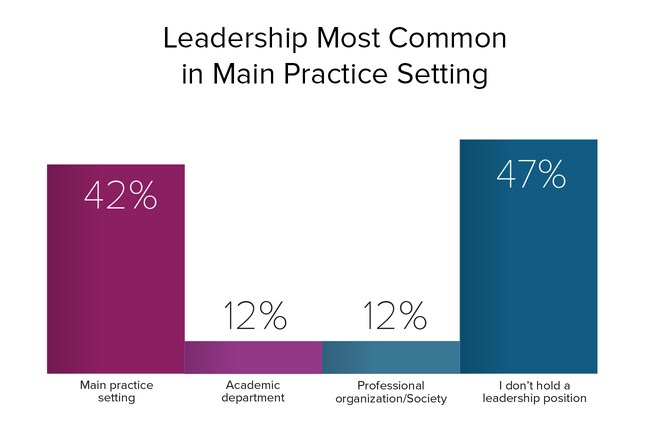
In the survey, women were identified as "leaders" if they held one or more positions of leadership in their main practice setting, a professional organization, or an academic department. Respondents were identified as "non-leaders" if they reported not holding any of these positions.
A leadership role in one's main practice setting was the most common. Overall, more than half of respondents (53%) report holding at least one leadership position, while slightly less (47%) said they don't hold any leadership positions.
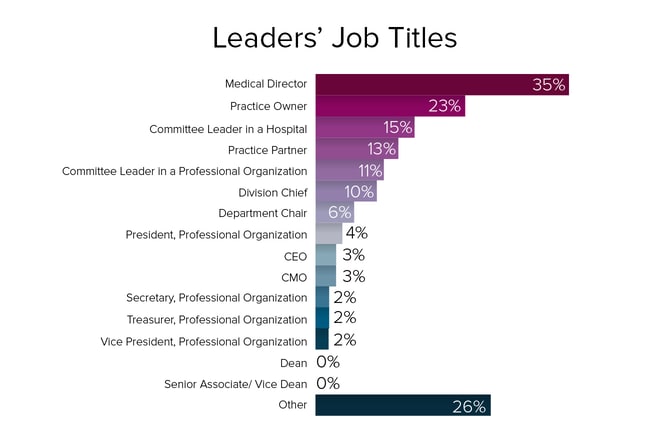
Among women who self-identified as holding a leadership position, the highest percentage reported being medical directors. This seems to be in line with other surveys reporting that women are increasingly filling these positions; a survey published in 2008 by the American College of Physician Executives and Cejka Search reported that 40% of female physician executives held the title of medical director.[6]
Women continue to represent only a small percentage of academia. According to a 2014 report from the Association of American Medical Colleges, women make up a little more than one third of full-time academic medicine faculty, including 15% of permanent department chair positions and 16% of dean positions.[4]
n=1764
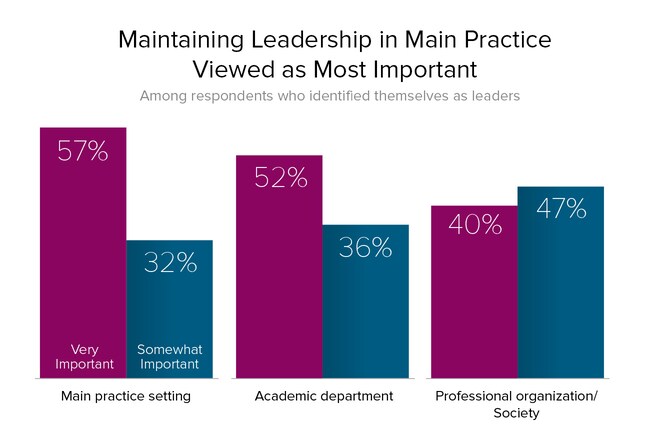
We asked leaders, "How important is it for you to maintain your leadership position(s) in the following setting(s)?"
Maintaining a position in one's main practice was viewed as slightly more important than maintaining positions in academia or a professional organization.
Main practice setting: n=1370; academic department: n=394; professional organization/society: n=394

Like female physicians who identify as leaders, female physicians not currently in leadership positions also view leadership in one's main practice setting as the most important. Nearly half of women physicians who aren't in leadership positions (43%) view attaining leadership in one's main practice setting as very or somewhat important, versus only 21% reporting the same for leadership in an academic department and 20% for a professional organization.
n=1521

Both leaders and non-leaders cite being a positive influence within an organization and effecting change as top reasons for serving in a leadership position. Less altruistic motivations, such as financial compensation, prestige, and bolstering a résumé ranked at the bottom.
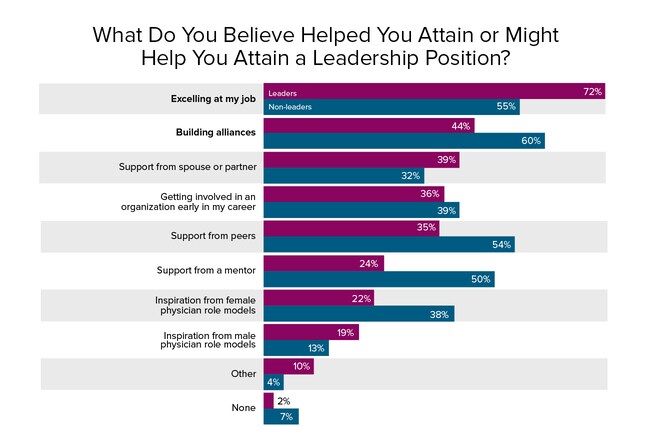
Women in leadership positions cite excelling at their jobs as the top factor that helped them get where they are. When asked what they believe would help them reach a position of leadership, non-leaders agree that excelling at their jobs is important, but they place more emphasis on building alliances with others and being bolstered by the support of peers, mentors, and role models. Specifically, non-leaders rate inspiration from female physicians (38%) as possibly being more helpful than inspiration from male physician role models (13%).
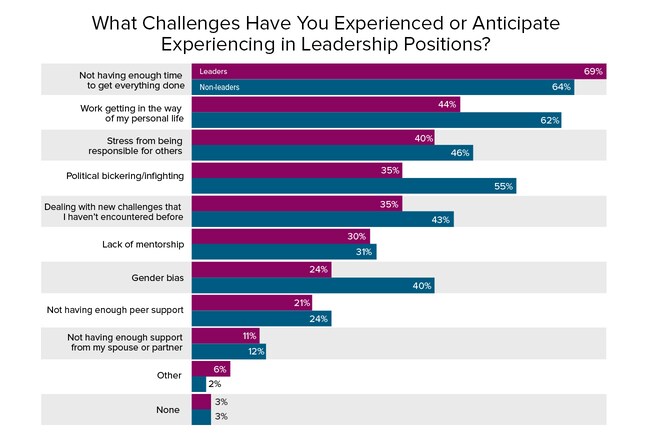
Not having time to get everything done, as well as work getting in the way of one's personal life, are top challenges experienced by leaders and are also the most commonly anticipated challenges among non-leaders.
However, while non-leaders cited political bickering/infighting (55%) and gender bias (40%) as challenges they anticipate in leadership positions, few leaders say that they've experienced these challenges (35% political bickering/infighting; 24% gender bias).

Despite more than half of all respondents saying that work tends to get in the way of their personal lives, a majority of leaders and non-leaders report being happy with their careers. Of note, slightly more leaders (72%) report being very happy or somewhat happy with their work lives than non-leaders (63%).
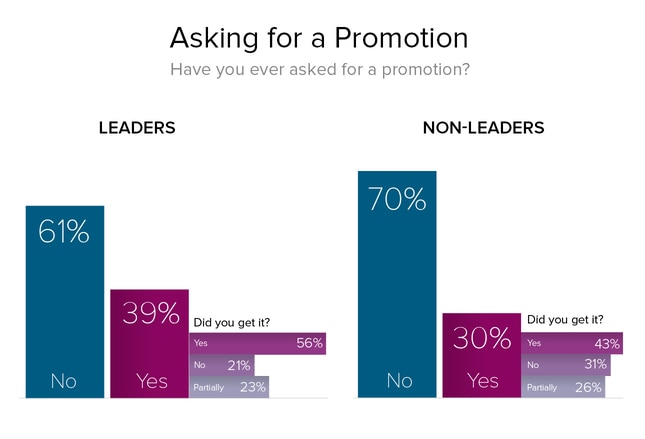
Roughly 1 in 3 female physicians surveyed have asked for a promotion at some point in their career, and roughly half received the promotion they sought. Leaders are more likely than non-leaders to have received a promotion and are also more likely to have asked in the first place.
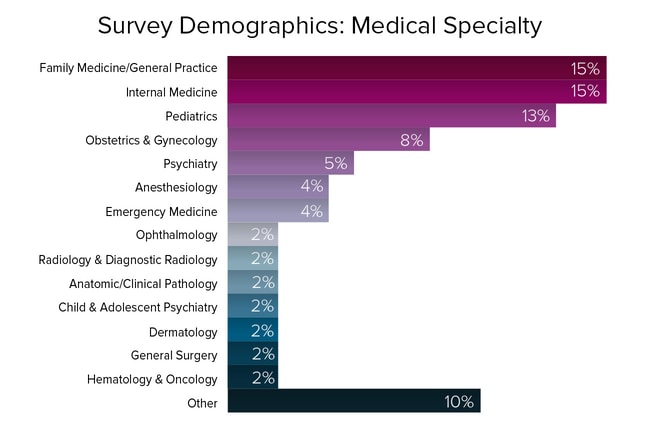
Most survey respondents practice family medicine, internal medicine, pediatrics, or obstetrics/gynecology, specialties that tend to attract more women.[7]
One percent of respondents cited working in the following specialties: allergy/immunology; cardiovascular disease; critical care medicine; endocrinology, diabetes, and metabolism; gastroenterology; geriatric medicine; infectious disease; internal medicine/pediatrics; neonatal/perinatal medicine; nephrology; neurology; physical medicine and rehabilitation; preventive medicine; rheumatology.
Less than 1% of respondents cited working in these specialties: interventional cardiology; neurologic surgery; neuroradiology; orthopedic surgery; otolaryngology; pain medicine and management; plastic surgery; pulmonary disease; radiation oncology; thoracic surgery; urology; vascular and interventional radiology; vascular surgery.
n=3285
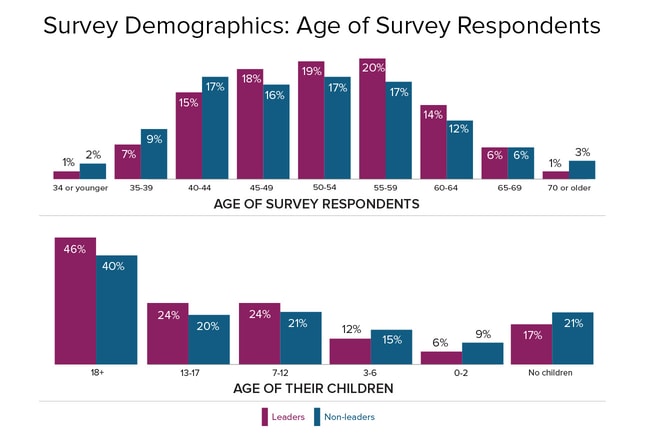
Respondents were fairly evenly distributed by age, with 36% in their 50s, 33% in their 40s, 21% over 60, and 9% under 40. Importance of leadership on a personal level is high across age groups.
No meaningful correlation was found between age of their children and possession of or interest in leadership.
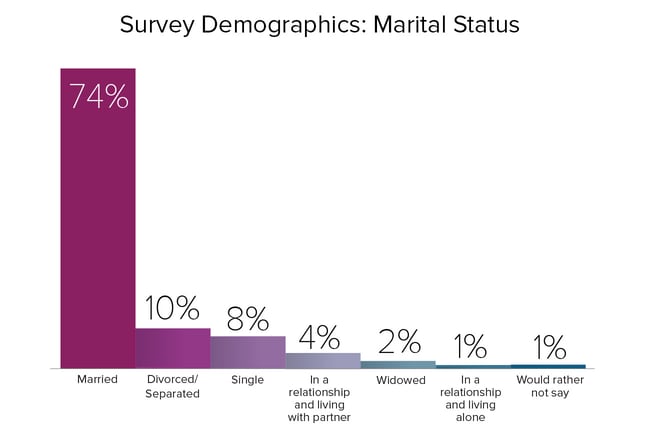
The vast majority of both leaders and non-leaders report being married. Relationships seem to have a strong influence on the careers of female respondents; roughly a third of leaders and non-leaders cited support from their spouses and partners as a factor that helped them or might help them attain a leadership position.
 Previous
Next
Previous
Next 
| 0 | of | 00 |
